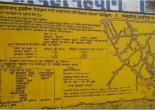- Skip to main content
- Skip to navigation
- Screen Reader Access
- Text Size
- Select Theme Default Theme Yellow Theme Pink Theme Blue Theme
- हिंदी में
- Home
- Innovations
INNOVATIONS AT A GLANCE:
INNOVATIONS AT A GLANCE: It is common knowledge that sector wide reform cannot be ushered in overnight. However, the steps taken must head towards the sector agenda and goals.
(i) Habitation as unit of planning: The habitation is the focal point for planning, implementation, operation & maintenance of the water supply scheme, rather than revenue village or the Gram Panchayat (GP).
(ii) Legality to the User Water & Sanitation Sub Committee (UWSSC): Appropriate provisions have been made in the Panchayat Raj Act of the State to bestow legality to the UWSSC as per 73rd Constitutional Amendment.
(iii) Model Bye-laws for functioning of UWSSC: Model bye-laws have been put in place for smooth conduct of business of UWSSC.
(iv) Fine-tuning of Support Organizations’ (SOs) Selection Criteria: Support Organization are selected using comprehensive eligibility criteria in order to weed out ‘Bad quality’ from ‘Good quality’ SOs.
(v) Integrated delivery of water supply services: The water supply schemes are integrated with catchment area programs, household and village environmental sanitation programs, solid waste management and health and hygiene awareness promotion programs, in order to maximize water supply and health benefits to the communities.
(vi) Constitution of district level Technical Review Committee (TRC): A district level TRC is constituted to review the technological options proposed by the various User Groups, analyze the justification of Single Village Scheme (SVS)/Multi Village Scheme (MVS), and to finalize the scheme identification plan.
(vii) Single Set of Schedule of Rates: The district schedule of rates for various engineering items/ works/materials (local and non local) are jointly prepared by all the three implementing agencies and approved by the District Water & Sanitation Mission (DWSM).
(viii) Capacity building of all stakeholders: Special training programs have been developed and implemented through the local training institutions to sensitize the state, district and village stakeholders and functionaries regarding the RWSS SWAp program.
(ix) Information, Education, and Communications (IEC): IEC activities through workshops, cross-visits, competitions, IEC stalls, TV programs, etc. A couple of short documentary films have been prepared on the good practices currently being implemented under the project. A quarterly newsletter- ‘Swajal Samachar’ is regularly published for dissemination of project philosophies and principles as well as experience sharing and lessons learnt.
(x) Insurance of the schemes: Insurance is an instrument through which sustainability of the water supply scheme is ensured during the construction phase in natural calamities dominated state like Uttarakhand.
(xi) Social audit committee: At the GP level a Social Audit Committee has been constituted for rectifying the problems related to construction of scheme. The main role and responsibilities of Social Audit Committee is (i) to ensure that all the committees follow Procurement Manual; (ii) Report any violation or deviation of rules to GP; (iii) Monitor the adherence of project principles and rules in selection of beneficiaries; (iv) Oversee the implementation of sub projects and all decisions of UWSSC
(xii) Monitoring and performance tracking: A web based robust monitoring and performance tracking system is in place to monitored processes, inputs, outputs and outcomes, including indicators of change under the project. The URL is http://swajalsis.uk.gov.in/ Password is not required for access of online data reports. The reports, inter-alia, which can be seen include (i) Pre planning Phase (ii) Planning Phase (iii) Detailed Project Report (DPR) detail (iv) Implementation Phase (v) Contract details (vi) Baseline data (vii) MVS and (viii) O & M
(xiii) Elaborate Exit Strategy: The Exit or ‘Atmarpan’ is a process of gradual withdrawal of the SO and the DIA from the village in anticipation that the community has been empowered to operate and maintain its water supply and sanitation schemes on its own. The project has put in place an elaborate exit policy to ensure sustainability of the created assets.
(xiv) Sustainability Evaluation Mechanism: The project has designed a Sustainability Evaluation Exercise (SEE) to assess the sustainability of completed schemes which are more than one year old.
(xv) Independent reviews are an integral part of the project processes including concurrent monitoring during the scheme planning phase, Third Party Construction quality checks, technical audits, social audits and grievance redressal during the scheme implementation phase.






